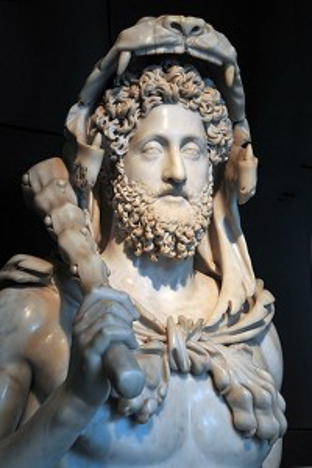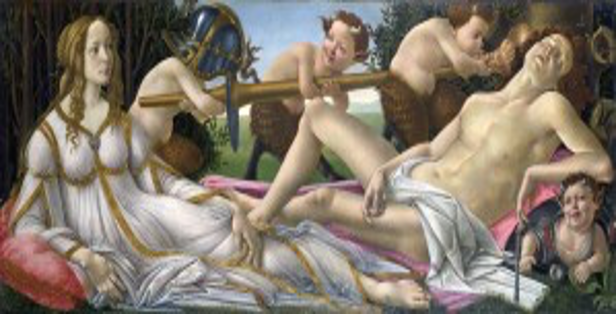Introduction
During the Renaissance, which occurred between 1400 and 1650, one of the most significant trends that emerged was humanism. The humanism movement of the Renaissance, which had its roots in Italy, was characterized by a shift away from the medieval tradition, which had been closely associated with righteous religious motivation in literature and the arts, and toward the adoption of a new way of life that valued secularism and materialism (Godbout, 2020). This shift occurred as a result of the Renaissance. Even though Botticelli was possibly the most influential humanist artist of the early Renaissance, many aspects of his life and the factors that shaped him remain a mystery to modern-day audiences (“How did Renaissance art reflect humanist concerns? ” 2022). His paintings are considered the apex of Florence’s artistic and philosophical development under the Medicis’ reign, a prosperous society that reinforced the development of literature, philosophy, and art. During his long profession, he was committed to depicting a wide diversity of subjects; yet, the values of beauty and morality exemplified by the goddess Venus, who serves as the subject of numerous of his most well-known paintings, were always the driving forces behind his work. In general, this paper aims to investigate the extent to which the art of Botticelli reflects the humanistic ideals of the early Renaissance period.
“Renaissance” refers to an artistic and intellectual movement that originated in Florence and spread throughout various fields, most notably art. It is essential to grasp the roots of Botticelli’s humanism before attempting to comprehend the humanism-inspired concepts he depicted in his paintings. Botticelli was influenced by several humanists, including Landino Dante, considered the most emblematic early Renaissance poet. In his poem Divina Commedia, Dante conveyed his enthusiasm for the highest human ideals like knowledge, virtue, love, philosophy, and glory. In this work, he also provided an allegory of the hereafter (“How did Renaissance art reflect humanist concerns? ” 2022). Botticelli wrote commentaries on Dante’s work and drew pictures, which are indicators of Dante’s effect on Botticelli’s concept of human consciousness. Botticelli also illustrated Dante’s works himself. Dante’s depiction of Earth Paradise in the Divina Commedia inspired Botticelli to create his masterpiece, Primavera (fig.1). Since Lorenzo must accept each of Botticelli’s creations, the humanist principles of individualism and human consciousness, along with Ficino’s explanation of mythology, particularly on Venus, are described in Botticelli’s paintings (Lugli, 2023). The humanism of Ficino was evident in Botticelli’s creations. Being surrounded by these significant figures in the evolution of humanism makes it unsurprising that Botticelli’s art is so delightfully rich in humanistic elements like individuality and human consciousness (Godbout, 2020). Additionally, it is not surprising that his work is such a fantastic combination of Neoplatonism and classism because of this.
In the fifteenth century in Florence, following a lengthy and gloomy period known as the Middle Ages, a movement known as the Renaissance, which means “rebirth,” took place. This movement aimed to restore ancient Greek and Roman civilization, including classical philosophy, literature, and science. During this time, humanism, an ideology that encompasses ideas like individualism and human consciousness, was widely esteemed and emerged as a preeminent concept in artistic production (Godbout, 2020). These humanistic concepts were infused into Botticelli’s work, including religious paintings, mythology paintings, and portraits. Botticelli was one of the most prominent painters working during the early stages of the Renaissance. Botticelli depicted ancient figures in their naked, natural states and brought the concept of human knowledge into his work with a mythological basis (“How did Renaissance art reflect humanist concerns? ” 2022). The example of The Birth of Venus best demonstrates this. Botticelli employed the legendary character Venus to represent human consciousness in several works, including Primavera, Mars, and Venus (fig.2). Both are considered among his most famous works. Botticelli’s religious works, such as “The Adoration of the Magi,” were created with humanistic individuality in mind. One such artwork is “The Adoration of the Magi.” Botticelli’s individualistic narrative can also be reflected in the artist’s portraits.
Botticelli employed the naked body as a symbol of the reappraisal of human values and the restoration of antiquity in his mythology paintings. The work of Leonardo da Vinci inspired these paintings. The ancient Greeks and Romans frequently depicted masculine figures in their statues of heroes and emperors without clothing. For example, the statue depicting Emperor Commodus in the role of Hercules demonstrated the might and authority of Commodus, the present leader. Additionally, these people employed the female form to symbolize ancient literature and art. Nakedness had a different connotation between the Romans and the Renaissance in the Middle Ages (Lugli, 2023). During that period, nudity was seen to be impolite, embarrassing, and a symbol of human failing due to the sexuality that it contained. Botticelli was not constrained by the usual concept of nudity that prevailed during the medieval period (Godbout, 2020). To construct the naked Venus, he used elements from antiquity as well as sculptures from Greece as his primary sources of inspiration. Venus comes from the water and descends on the ground in this author’s work titled “The Birth of Venus.” She stands there naked, like a statue from ancient Greece, with her dominant arm concealing her breast (Nelson, 2022). The flower shower is tumbling through her hair, which is a light brown color. She stands there in complete silence and melancholy, encased in a white shell that stands for love. Zephyr bestows her the life spirit in the upper left-hand corner of the image. Even though he is naked, he does not have the same amount of muscle definition as the Roman and Greek male statues. On the painting’s right side, Nymph Hour is shown dressing Venus in a cloak she had brought.
Botticelli achieved the harmonious and calm setting he was going for by using lines that were smooth but lively and vivid colors. The naked Venus is arranged artistically for the audience’s viewing pleasure. Botticelli’s expertise in depicting human figures, particularly facial characteristics and shade, contributes to the impression that the female god is gentle (Nelson, 2022). Despite being naked, Venus is chaste, innocent, and classical; nonetheless, she is not seductive. The depiction of a naked Venus effectively communicates the splendor of the human form, the goodness of human beings, and the logic of human brains.
Botticelli took a different style to express the general humanist principles during the early Renaissance. Botticelli moved away from the religious influence prevalent in art during the Middle Ages and toward a more humanistic perspective by incorporating spiritual elements into his work. This was done for several reasons. Most religious paintings refrained from utilizing a wide range of colors when depicting the scenario, which included both Jesus and Mary. Because of the widespread assumption that Jesus was a divine person, painters were obligated to incorporate a variety of characteristics that were taken directly from the biblical accounts of Jesus’ life. In addition, earlier depictions of Jesus avoided using colors, lines, or objects that would highlight any human or worldly part of the artwork. This was done so that the focus would remain entirely on Jesus.
Additionally, to demonstrate holiness and righteousness, the mother and the infant were expected to be dressed in the same vibrant hue. The angel was expected to be a man, and it was preferred that he have wings. Botticelli, on the other hand, does not incorporate these features, which provides evidence of his capacity to include a humanistic approach to religious art during the Renaissance period (Nelson, 2022). Venus, the Roman goddess, is in the center of the painting. Her presence in Florence during this period illustrates the widespread humanist interest in the realm of classical antiquity that prevailed in Florence at that time. She is portrayed as a woman’s ideal, slightly off-center, having her head cocked to the right and gesturing to the right side of the canvas. The fact that Botticelli eventually became extremely religious underneath the influence of the stringent Dominican monk Girolamo Savonarola and repudiated his humanist works is an exciting facet of this humanist picture. Botticelli is credited with painting the Birth of Venus. He may have been responsible for burning many people’s vanity items at the Bonfire of the Vanities (Nelson, 2022). He abandoned the pre-Christian and pagan themes and shifted his focus to devoted Christian ideas. The carefree and playful quality of his earlier pagan paintings was absent from his later Christian paintings, which were more structured and rigid.
Conclusion
The utilization of perspective and human anatomy in Sandro Botticelli’s artworks are two examples of how humanist realism can be seen in his work. In Botticelli’s early religious works, such as his depiction of the Adoration of the Magi, instead of highlighting gods’ divinity, Botticelli depicts them with similar features as ordinary humans. One example of this may be seen in Botticelli’s portrayal of the adoration of the magi. The philosophical movement known as humanism, which praised classical studies and individualism and investigated human lives and virtues, was a significant source of inspiration for Botticelli. The dependence of The Birth of Venus on classical myth and art, as well as its emphasis on romantic love, are all ways in which these ideas are explored.
References
Godbout, B., 2020. From the Primavera to the Mystic Nativity: Reconciling the Early and Late Work of Sandro Botticelli.
How did Renaissance art reflect humanist concerns? (2022, February 8). Student-Centered World: A Student-Centered Learning Resource. https://www.studentcenteredworld.com/how-did-renaissance-art-reflect-humanist-concerns/
Lugli, E., 2023. Knots, or the Violence of Desire in Renaissance Florence. University of Chicago Press.
Nelson, J.K., 2022. Filippino Lippi: An Abundance of Invention. Reaktion Books.
List of Images
Figure 1

Figure 2

 write
write